Star Trek technology becomes more science than fiction
New devices are catching up to the tech found in the long-running sci-fi series
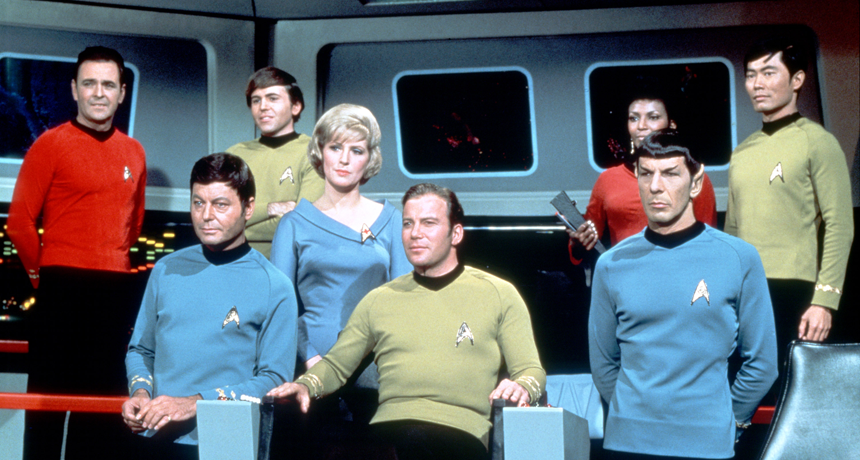
The TV show Star Trek brought together a diverse crew to explore outer space. It also inspired generations of scientists.
CBS
Fifty years ago, the first episode of Star Trek aired. It started as a quirky science-fiction television show that lasted for a mere three seasons. But the out-of-this world series launched a long-running story that went on to capture the imaginations of generations of viewers. It has left its fingerprints not only on pop culture but also on the world of science.
The original Star Trek followed a multicultural space crew in the 23rd century as it traveled to distant corners of the galaxy on its ship, the Enterprise. Each episode began with the captain’s voice telling viewers that the crew’s mission was “to boldly go where no man has gone before.” Its officers and crew faced terrific challenges, hostile aliens and strange new planets. Though the series wasn’t a rampant success, it led to 13 movies and five more series over the following decades. A sixth series, Discovery, will begin airing in 2017.
Space may have been the “final frontier,” but it wasn’t the only one in this fictional world. Explorers on the Enterprise used a variety of futuristic tools, weapons and other technology that seemed wild and impossible. The ship traveled through space faster than light, at “warp speed.” It used something called a tractor beam to capture or tow other ships. In the face of danger, characters fired intense beams of light, or lasers, from weapons called phasers. To heal the sick, the ship doctor, “Bones” McCoy, scanned patients with a handheld device called a tricorder. (“Tri-“ comes from the Greek word for three. So, a tricorder could do three things: scan, record and compute.) Hostile alien ships could make themselves invisible by “cloaking.” And characters frequently used devices that acted very like today’s smartphones and tablet computers.
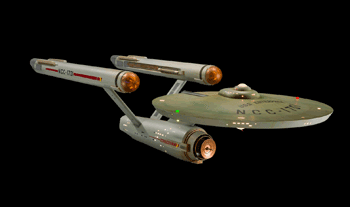
Star Trek’s vision was dazzling. “It showed you what a technological future could be like,” says David Grier. He’s a physicist at New York University in New York City. “I thought it was great.” Grier was a huge fan of the show. He admired how the doors swooshed open at just the right moment to let people pass. And he marveled at how all the devices worked together and from anywhere on the ship.
Grier and other scientists didn’t just goggle at these devices, though. They drew inspiration from them. They grew up to run their own scientific labs. And now these die-hard fans are actually building modern versions of some of Star Trek’s most fantastic devices. With their inventions now poised to enter the real world, Grier says today’s scientists are about two hundred years ahead of schedule.
I’m a doctor — and an inventor
Basil Harris is an emergency room doctor in Philadelphia, Pa., who grew up watching Star Trek. The show was notable not just for its gadgets, he says. He also liked how it depicted people working together to solve problems. They didn’t always get along. McCoy, for example, was a cranky physician who often quarreled with crew members. But he was part of the team. If one crew member was captured or endangered, the rest collaborated on a rescue.
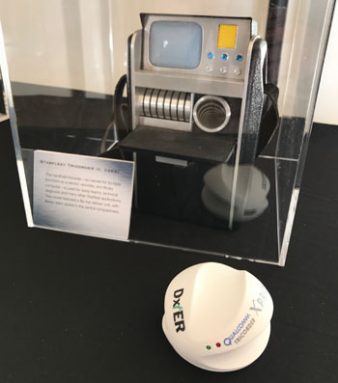
“They had a nice harmony,” Harris says. “It was an optimistic view of the future. How could you not like it?”
As a child, he could relate. He enjoyed working with his siblings on their own inventions. They created gadgets using whatever they could find to make it so. They once built a cotton candy machine using parts from a lawn mower and the largest pot from their mother’s cupboard. It worked, he says, but the cotton candy wasn’t great.
Much to the horror of his parents, “We were always taking things apart and putting them together in different ways,” he recalls. They considered it mischief. But “we were trying to create something new.”
As an adult, Harris is tinkering with his siblings again. But they’re not making cotton candy. They’re building a tricorder like the one McCoy used to diagnose illnesses on Star Trek. They began the project after Harris learned about the Qualcomm Tricorder XPrize. This contest will award $10 million to the team that builds the best tricorder. (It is sponsored by Qualcomm, a telecommunications company.)
Harris convinced his brothers to help him enter. “I told them, ‘It can’t be that hard! We’ll bang it out in a couple weekends.’” So far, they’ve now been working on it for three years. And the team has expanded beyond Harris and his brothers. His other siblings and three children help out, too. They have installed circuit boards in the devices and tested the plastic cases.
More than 300 teams entered the Star Trek-inspired XPrize competition. The field was narrowed down in 2014 to seven finalists, including Harris’ team. “We never thought we’d get this far,” he says. The final winner will be announced in early 2017.

To win, a team’s device must be capable of collecting data on a patient’s health. Those data include measurements such as blood pressure, temperature and breathing rate. The device has to accurately diagnose 12 diseases or health conditions. These include diabetes, pneumonia and urinary tract infections. It also must be able to tell if a patient has none of those conditions. And it has to weigh no more than 2.3 kilograms (5 pounds).
Harris isn’t only excited because of his appreciation for Star Trek — or even the possibility of a $10 million prize. As a physician in the emergency room, he often sees patients who would have benefited from having troublesome symptoms identified early. He says a tricorder may help future patients in big ways by doing just that.
It might allow patients to immediately learn what’s wrong with their health. In fact, he notes, “Someone could use this in their home to come up with answers before they go to the doctor.” And that might help them to “live long and prosper,” as Star Trek’s Spock was known to say.
Don’t leave spacedock without one
The tricorder may be on the horizon, but another Star Trek-inspired device is already here — the tractor beam. Well sort of, anyway. It’s just smaller than what appeared on the show. Much, much smaller.
The tractor beam first showed up in an episode on the first season of Star Trek. The crew had just discovered an old, quiet ship floating in space. When they detected life aboard it, they decided to investigate. To hold the other ship in place, they used a tractor beam. In another episode that season, an alien named Balok wanted to destroy the Enterprise. When the crew first encountered Balok’s ship, they couldn’t seem to get away.
“Tractor beam, Captain,” Spock explained to Captain Kirk. “Something’s grabbed us, hard.”
Balok had used a tractor beam to trap the ship. Eventually, the Enterprise’s engines proved powerful enough to break out, and the crew survived to have another adventure.
Those tractor beams on Star Trek were streams of particles called gravitons. As their name suggested, these particles used gravity to pull or trap a ship. In the real world, scientists have never observed or measured gravitons. But tractor beams do exist. They’re not quite like the ones on Star Trek. And they don’t use gravity. Instead, they use light. Most importantly, they can’t drag something as big as a spaceship.
Grier, at New York University, led the development of the first one. His team’s invention uses lasers — beams of light — to pull tiny plastic particles only about 400 nanometers in diameter. (That’s roughly one ten-thousandth of an inch, or the width of a large virus.)
In 2010, when his team first published a description of their device, Grier didn’t know what to call it.
“We didn’t want to call it a ‘tractor beam’ because that was too commercial,” he says. After all, he was doing serious science, not working in science fiction. “We tried everything we could think of without saying ‘tractor beam.’” Now, Grier embraces the term because that’s exactly what he’s built.
(Story continues below video)
Where tractor beams come from
The science behind his invention goes back more than 150 years. That’s when British physicist James Clerk Maxwell discovered that a beam of light pushes — very lightly — on the thing it hits. This force is called radiation pressure. The idea that light can nudge tiny particles is exciting to scientists. It means they can move miniscule objects around under a microscope, or in experiments, without having to physically touch them.
In 1986, Arthur Ashkin, a physicist at Bell Laboratories in Murray Hill, N.J., built on that idea. He showed how a focused laser beam could hold particles in place. Scientists call his invention an “optical tweezers.”
In the 1990s, Grier began running his own experiments with optical tweezers. By changing the shape of the beam of light, he was able to get it to pull, rather than push, particles.
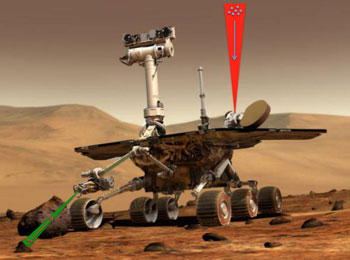
Grier ran a lot of unsuccessful experiments. When he finally got the device to work, it moved a small plastic particle two micrometers upstream. (A micrometer, or micron, is one-millionth of a meter. Two micrometers is about one-tenth the diameter of the thinnest human hair.)
“We were pumped,” he says, even though “it went two microns in the wrong direction!” Since then, he’s been improving his methods. Now, he says, he can drag particles nearly a millimeter (0.04 inch). In theory, a scaled up tractor beam might one day draw some object to its source from up to about one kilometer (0.6 mile) away.
Grier’s technology may not drag spaceships. Still, it might prove useful in space. NASA is working with Grier to use his tractor beam technology in future missions. The tool might draw dust from a comet’s tail. The physicist sees his tractor beam as a tool that should be able to help scientists better study matter at the smallest scales.
“In the microscopic world, there are lots of secrets to be discovered,” he notes.
‘Set phasers to stun’
Grier’s beam uses lasers. So does another emerging technology that played an important role in Star Trek — laser weapons.
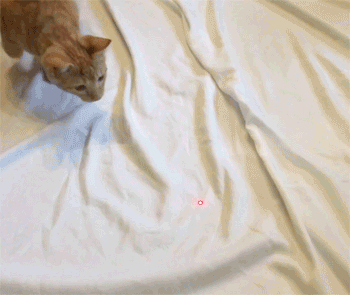
The first laser was created in 1960. That was six years before the first Star Trek episode appeared on televisions. Ever since, lasers have been a staple of science fiction — often used in ways beyond the reach of modern science. But science is at last catching up.
On Star Trek, characters used the lasers from handheld phasers to heat objects, stun assailants and kill enemies. The Enterprise also could fire powerful lasers to stop or destroy enemy ships.
Lasers are now almost ubiquitous — but usually not as weapons. They read data stored on a compact disc (CD) or digital video disc (DVD). Surgeons use lasers to perform precise operations, as on the eye or the spine. Lasers can even be used to remove tattoos. And millions of cat owners occupy their pets with tiny laser toys.
Some scientists, though, have been working to weaponize lasers, bringing Star Trek’s vision closer to reality. One of those scientists is Rob Afzal, who develops laser weapons as part of Lockheed Martin’s Laser and Sensor Systems, near Seattle, Wash. This aeronautics company designs and builds new weapons for the U.S. military. The company has already built a laser defense system that can be used on land, in the air or on the sea.
Using precise, powerful lasers as weapons has long been a goal of the U.S. military. In March 2015, the company demonstrated a laser that could burn a hole through 5 centimeters (2 inches) of steel in a few seconds. That’s powerful enough to stop a truck or an incoming missile. But that’s only the beginning: The company is now developing a laser twice as powerful.
According to Lockheed calculations, the weapon system is precise enough to burst a beach ball perched on the Empire State Building — in New York City — using the beam from a laser on a bridge in San Francisco, Calif. The system uses light, lenses, mirrors and computer programs to aim and focus the beam.
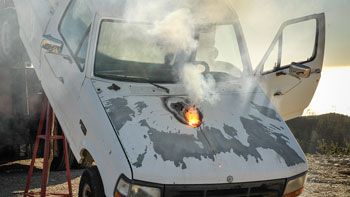
Such a laser requires a lot of energy. Lockheed Martin’s system is so large it has to be mounted on the back of a truck. In order to develop handheld phasers like the ones used on Star Trek, scientists will have to figure out how to pack a lot of energy into a small space.
Afzal described the technology in a recent documentary called “Building Star Trek,” which was produced by the Smithsonian Channel. “It’s difficult to predict the future, but I would never bet against science,” he says in the film.
With Star Trek technology, resistance is futile
Not every idea on Star Trek is destined to become real. We may never teleport objects. People will never get the chance to ask the equivalent of Scotty to “beam me up.” And the speed of light is a universal speed limit, so it’s unlikely we’ll ever go any faster. But other once-fascinating gadgets have already become ordinary, such as communicators or universal translators (think smartphone). Others may join them in just a few years.
Grier says he hopes another idea from Star Trek catches on. It’s more about people than about the gadgets they use. Every character, he notes, seemed to know how their devices worked. And they knew how to fix them if they broke. In the real world, few people know how phones or laptops connect us to the world. They use technology without understanding.
“To most people, technology might as well be a miracle,” he says.
He wants that to change. Star Trek paints a future where people understand their devices. Grier hopes people learn about how their gadgets work in the real world, too. That could help them to better use those devices for good causes.
Scientists are already doing that, he notes. Yes, emerging technologies help scientists tease out the secrets of nature, says Grier. “You can develop a new way to see things,” he says. And making these futuristic-seeming tools, like tractor beams, is satisfying for a scientist. But this type of research is more than that. “You can have an influence on the real world, and make things better,” Grier says. And maybe bring a bit more of that amazing world of Star Trek into reality.







